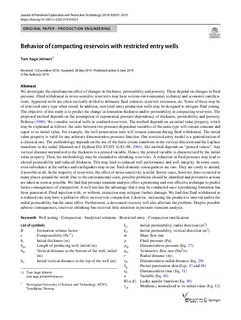| dc.contributor.author | Jelmert, Tom Aage | |
| dc.date.accessioned | 2020-02-07T07:12:12Z | |
| dc.date.available | 2020-02-07T07:12:12Z | |
| dc.date.created | 2019-07-08T18:51:09Z | |
| dc.date.issued | 2019 | |
| dc.identifier.citation | Journal of Petroleum Exploration and Production Technology. 2019, 9 (4), 3007-3019. | nb_NO |
| dc.identifier.issn | 2190-0558 | |
| dc.identifier.uri | http://hdl.handle.net/11250/2640131 | |
| dc.description.abstract | We investigate the simultaneous effect of changes in thickness, permeability and porosity. These depend on changes in fluid pressure. Fluid withdrawal in stress-sensitive reservoirs may have serious environmental, technical and economic ramifications. Appraisal wells are often vertically drilled to delineate fluid contacts, reservoir extension, etc. Some of these may be of restricted entry type when tested. In addition, restricted entry production wells may be designed to mitigate fluid coning. The objective of this study is to predict the change in formation thickness and/or permeability in compacting reservoirs. The proposed method depends on the assumption of exponential pressure dependency of thickness, permeability and porosity, Pedrosa (1986). We consider vertical wells in confined reservoirs. The method depends on an initial value property, which may be explained as follows: the ratio between two pressure-dependent variables of the same type will remain constant and equal to its initial value. For example, the well penetration ratio will remain constant during fluid withdrawal. The initial value property is valid for any arbitrary dimensionless pressure function. Our restricted entry model is a generalization of a classical one. The methodology depends on the use of the finite cosine transform in the vertical direction and the Laplace transform in the radial (Hantush in J Hydraul Div 87(HY 4):83–98, 1961). His method depends on “primed values”. Any vertical distance normalized to the thickness is a primed variable. Hence, the primed variable is characterized by the initial value property. Then, his methodology may be extended to shrinking reservoirs. A reduction in fluid pressure may lead to altered permeability and reduced thickness. This may lead to reduced well performance and well integrity. In some cases, even subsidence at the surface and earthquakes may occur. Such dramatic consequences are rare. They are costly to amend, if possible at all. In the majority of reservoirs, the effect of stress sensitivity is mild. Severe cases, however, have occurred in many places around the world. Due to the environmental costs, possible problems should be identified and preventive actions are taken as soon as possible. We find that pressure transient analysis offers a promising and cost-effective technique to predict future consequences of compaction. A well test has the advantage that it may be conducted once a producing formation has been penetrated. Fluid injection with, or without, extraction may mitigate further damage. We find that fluid withdrawal at a reduced rate may have a palliative effect on reservoir compaction. Likewise, increasing the productive interval and/or the radial permeability has the same effect. Furthermore, a decreased viscosity will also alleviate the problem. Despite possible adverse consequences, reservoir shrinking has received little attention in pressure transient analysis. | nb_NO |
| dc.language.iso | eng | nb_NO |
| dc.publisher | Springer International Publishing | nb_NO |
| dc.rights | Navngivelse 4.0 Internasjonal | * |
| dc.rights.uri | http://creativecommons.org/licenses/by/4.0/deed.no | * |
| dc.title | Behavior of compacting reservoirs with restricted entry wells | nb_NO |
| dc.type | Journal article | nb_NO |
| dc.type | Peer reviewed | nb_NO |
| dc.description.version | publishedVersion | nb_NO |
| dc.source.pagenumber | 3007-3019 | nb_NO |
| dc.source.volume | 9 | nb_NO |
| dc.source.journal | Journal of Petroleum Exploration and Production Technology | nb_NO |
| dc.source.issue | 4 | nb_NO |
| dc.identifier.doi | 10.1007/s13202-019-0700-3 | |
| dc.identifier.cristin | 1710704 | |
| dc.description.localcode | Open Access This article is distributed under the terms of the Creative Commons Attribution 4.0 International License (http://creativecommons.org/licenses/by/4.0/), which permits unrestricted use, distribution, and reproduction in any medium, provided you give appropriate credit to the original author(s) and the source, provide a link to the Creative Commons license, and indicate if changes were made. | nb_NO |
| cristin.unitcode | 194,64,90,0 | |
| cristin.unitname | Institutt for geovitenskap og petroleum | |
| cristin.ispublished | true | |
| cristin.fulltext | original | |
| cristin.qualitycode | 1 | |

